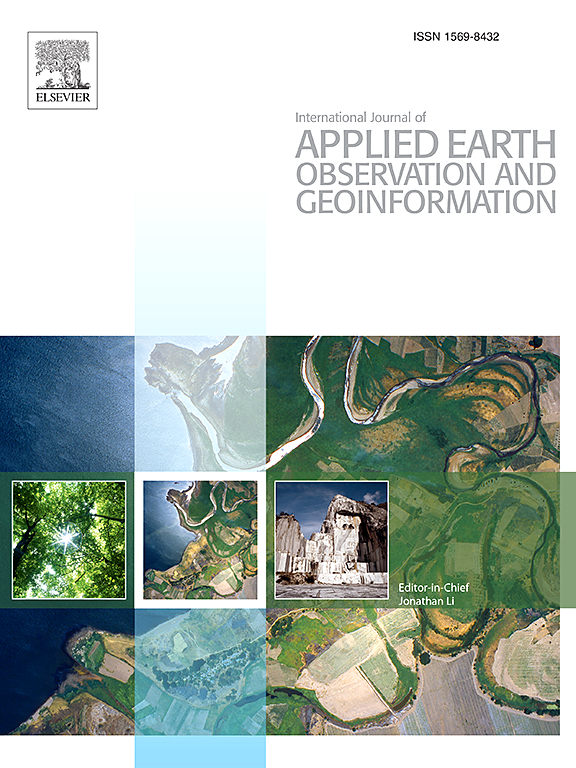Detection and mapping of Antarctic lichen using drones, multispectral cameras, and supervised deep learning
IF 8.6
Q1 REMOTE SENSING
International journal of applied earth observation and geoinformation : ITC journal
Pub Date : 2025-06-02
DOI:10.1016/j.jag.2025.104577
引用次数: 0
Abstract
The difficulty of accurately detecting lichens in Antarctic landscapes, due to their fine-scale spatial patterns and low spectral contrast, drives the need for high-resolution drone-based remote sensing imagery to develop and validate robust mapping methods. Few studies have explored the use of remote sensing and deep learning (DL) techniques for mapping and monitoring lichen density in Antarctic regions. This study aims to fill this gap by using multispectral (MS) cameras onboard uncrewed aerial vehicles (UAVs) and DL to detect and map Antarctic lichen through a workflow that enhances detection using a semi-automatic labelling technique based on vegetation indices (VIs). This methodology was validated through a data collection campaign at Robinson Ridge, Windmill Islands, Antarctica in January 2023. Two DL methods were evaluated to classify and map Usnea spp., Umbilicaria and Pseudephebe species (black lichen), moss and non-vegetation: method (1) standalone DL model fitting, namely fully convolutional network (FCN), U-Net, and Deeplabv3+, with semi-automatic labelling thresholding using VIs; and method (2) ensemble stacking by using eXtreme gradient boosting (XGBoost) as the input model, whose predictions are used as features for training a U-Net model. In Method 1, U-Net exhibited the best performance over the other models. Specifically, for Usnea spp., the results demonstrate an intersection over union (IoU) of 84%. Also, the black lichen class obtained an IoU of 86%. In contrast, Method 2, which employed the ensemble stacking technique, demonstrates an IoU of 71% for Usnea spp. and IoU of 75% for black lichen. This study provides promising evidence that using MS cameras on UAVs combined with DL models is an effective approach for detecting and mapping lichen density in Antarctica, though further exploration across diverse regions is recommended to validate its scalability and adaptability.
使用无人机,多光谱相机和监督深度学习探测和绘制南极地衣
由于地衣具有精细的空间格局和低光谱对比度,在南极景观中准确探测地衣存在困难,因此需要基于无人机的高分辨率遥感图像来开发和验证稳健的制图方法。很少有研究探索利用遥感和深度学习(DL)技术绘制和监测南极地区地衣密度。本研究旨在填补这一空白,通过使用无人机(uav)上的多光谱(MS)相机和DL,通过使用基于植被指数(VIs)的半自动标记技术增强检测的工作流程来检测和绘制南极地衣。该方法于2023年1月在南极洲Windmill群岛的Robinson Ridge进行了数据收集活动。评估了两种深度学习方法对Usnea spp.、umbilaria and pseudohebe species (black lichen)、moss和non-vegetation进行分类和定位:方法(1)独立深度学习模型拟合,即全卷积网络(FCN)、U-Net和Deeplabv3+,使用VIs进行半自动标记阈值分割;方法(2)采用极端梯度增强(XGBoost)作为输入模型的集成叠加,其预测结果作为训练U-Net模型的特征。在方法1中,U-Net比其他模型表现出最好的性能。具体来说,对于Usnea spp来说,结果显示了84%的交叉union (IoU)。此外,黑地衣类获得了86%的借据。相比之下,采用集合叠加技术的方法2显示Usnea spp的IoU为71%,黑色地衣的IoU为75%。这项研究提供了有希望的证据,证明在无人机上使用MS相机结合DL模型是检测和绘制南极洲地衣密度的有效方法,尽管建议在不同地区进行进一步的探索,以验证其可扩展性和适应性。
本文章由计算机程序翻译,如有差异,请以英文原文为准。
求助全文
约1分钟内获得全文
求助全文
来源期刊

International journal of applied earth observation and geoinformation : ITC journal
Global and Planetary Change, Management, Monitoring, Policy and Law, Earth-Surface Processes, Computers in Earth Sciences
CiteScore
12.00
自引率
0.00%
发文量
0
审稿时长
77 days
期刊介绍:
The International Journal of Applied Earth Observation and Geoinformation publishes original papers that utilize earth observation data for natural resource and environmental inventory and management. These data primarily originate from remote sensing platforms, including satellites and aircraft, supplemented by surface and subsurface measurements. Addressing natural resources such as forests, agricultural land, soils, and water, as well as environmental concerns like biodiversity, land degradation, and hazards, the journal explores conceptual and data-driven approaches. It covers geoinformation themes like capturing, databasing, visualization, interpretation, data quality, and spatial uncertainty.
 求助内容:
求助内容: 应助结果提醒方式:
应助结果提醒方式:


